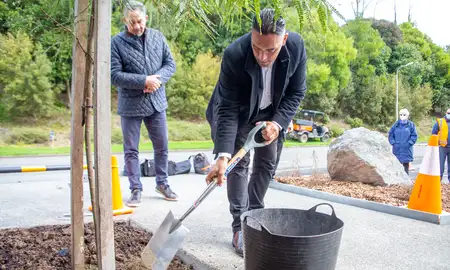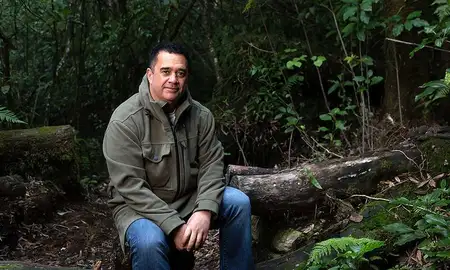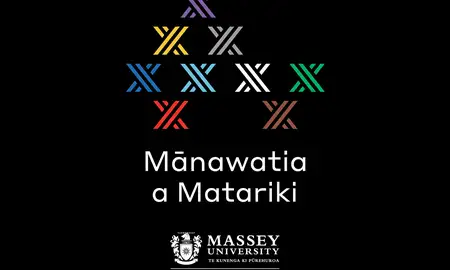
Over the past decade we have seen a phenomenal growth in interest across Aotearoa New Zealand in celebrating and acknowledging Te Mātahi o te Tau, the Māori New Year. Te Rā Aro ki a Matariki / Matariki Observance Day is a watershed moment for Aotearoa, as it is a truly Māori based celebration of who we are, what we stand for, what we value and the principles we aim to ascribe to. Unlike many of the other holidays and celebrations, most of which originate from the Northern Hemisphere, Matariki not only has its origins in Te Moana-nui-a-Kiwa but also in the places and spaces of Aotearoa, the place we call home.
Te Rā Aro ki a Matariki is an opportunity for us to celebrate together and recognise and embrace a significant event that is based on multiple interpretations of mātauranga, where we are all able to participate with shared values and principles we can relate to. It is a time for us to remember the past, celebrate the present and plan for the future.
In leading plans for instituting the new Matariki holiday, New Zealander of the Year Professor Rangi Mātāmua gathered experts in Māori and western astronomy, celestial navigation and education to develop the fundamental principles and values of what this holiday would look like and how New Zealanders could celebrate and acknowledge this time. These principles and values were based on aspects of ceremonies that are conducted during the time of Matariki.
There are three guiding principles to the celebration of Matariki:
- Remembrance – Honouring those we have lost since the last rising of Matariki
- Celebrating the present – Gathering together to give thanks for what we have
- Looking to the future – Looking forward to the promise of a new year
There are also a number of key values:
- Aroha – Love and respect for one another
- Whakamaumaharatanga - Remembrance
- Kotahitanga – Unity
- Manaakitanga – Caring
- Tohatoha - Sharing Mana
- Taiao – Environmental awareness
- Kaihaukai – Feasting
- Wānanga – Discussion
- Noho tahi – Coming together
- Ngākau Atawhai - Kindness
- Whakanui – Celebrations
- Tuakiritanga - Identity
Matariki is the name of a star cluster commonly known as Pleiades, M45 and the Seven Sisters of more than 800 stars, with only a handful visible to the naked eye. The cluster is an open one 444 light years from us and is known by many cultures around the world. Each year Matariki rises in the North-Eastern horizon in mid-winter to herald Te Mātahi o te Tau, the Māori New Year. Different communities acknowledge Puanga/Puaka (Rigel), Rehua (Antares), and/or Matariki as their focal point for their New Year.
The name Matariki is a truncated version of the longer name, Ngā mata o te ariki Tāwhirimātea, or the eyes of the god Tāwhirimātea. The long name has its origins in Māori cosmological traditions when Ranginui and Papatūānuku were bound together in a tight embrace and their children were cloaked in perpetual darkness.
“The children, the pantheon of Gods, eventually agreed, apart from Tāwhirimātea the god of winds and weather, to separate their parents as a course of action. Tāwhirimātea sought retribution from his siblings and he set forth on a series of attacks against them. His brothers cowered before his wrath except Tūmatauenga, the god of war and humanity: a warrior. Following an epic battle, Tūmatauenga triumphed, banishing his brother to the sky. Defeated and overcome with sorrow, Tāwhirimātea plucked his eyes and cast them into the heavens in a display of rage and contempt towards his siblings and aroha (love) for his father."
These ‘eyes’ became known as Matariki and the understanding of the origins of this expression is now gaining traction in mainstream consciousness. Rehua (Antares) took Matariki as his wife, who gave birth to eight children (five daughters and three sons), each child having a unique purpose, role and attribute that are connected to various domains.
For example, Rehua, is an ariki, a paramount chief associated with medicine and healing. Matariki is the conductor of the whānau,and is linked to wellbeing, good fortune and health. It is “…within both Rehua and Matariki that knowledge of wellbeing and medicine exists, and both have the power to heal’. Within Matariki, each of the whetū represent either a food, a source, a weather occurrence, the dead as well as the promise of a prosperous year, hopes and aspirations (like the notion of making a new year’s resolution or wishing upon a star).
Matariki (Alcyone) is the mother of the cluster who signifies reflection, hope, our connection to the environment and the gathering of people. Pōhutukawa (Sterope/Asterope) is female, the eldest and she is associated with the dead, especially those mate (dead) who have passed since the last rising of Matariki. Tupuānuku (Pleione) is female and is connected with everything that grows within the soil to be harvested or gathered for food. Tupuārangi (Atlas) is male and embodies food from the sky or in the trees – i.e., birds, fruits and berries. Waitī (Maia) is female and holds the essence of food found in freshwater and freshwater ecosystems. Waitā (Taygeta) is male and holds the essence of the food in salt water, the ocean and the food sources within it. Waipunarangi (Electra) is female and is connected with the rain. Ururangi (Merope) is male and is connected with the winds. Hiwa-i-te-rangi (Celaeno) is female and the youngest who is associated with the promise of a prosperous year, hopes, granting our wishes and realising our aspirations for the coming year.
During this period of celebration, we can acknowledge those who have passed away, we can come together as whānau, or community or organisation to share kai, check in with everybody and plan for the future. Matariki is a period to reflect on health and wellbeing, not just for us as humans, but also the health and wellbeing of our environment, ecological systems, the climate, and the whenua. It is a time for us to carefully consider our priorities and make plans for how to care for Papatūānuku and Ranginui.
Coinciding with the growth and expansion of Matariki celebrations is the regeneration of a number of traditional ceremonies that acknowledge the heliacal rising of Matariki: ‘Te taki mōteatea’ (reciting of laments) and ‘Whāngai i te hautapu’ (to feed with a sacred offering). Many communities across Aotearoa have been conducting their own ceremonies to honour the time of Matariki and Puanga which have contributed to the growing desire to reintroduce these ceremonies more broadly. This aspiration was realised at Te Papa Tongarewa with the practising of the Whāngai i te Hautapu Matariki Ceremony 2022 where the sacred ceremony was broadcast live to the nation which meant hundreds of thousands of us could observe, learn and participate as one.
Before the announcement of the new Matariki public holiday, many questions were raised, some around how we celebrate Matariki, while others raised questions around commercialisation and the economy. The answers to such questions are reflected in the values and principles that were developed to help guide us on how to celebrate Matariki. So, during Matariki we can travel home, share kai together and reconnect. We can go on a break away with our whānau and rest or we can go home and share time with whānau and friends. We can hold wānanga together, give back to the environment, be present with our whānau instead of buying presents, do activities together, eat locally and support local business. Most importantly we should view our beautiful night sky and connect with Ranginui and watch Matariki rise.
The development of social media platforms such as ‘Living by the Stars’ and the book ‘Matariki Star of the Year’ by Professor Mātāmua and work on the revitalisation of maramataka in Māori communities by the likes of renown maramataka expert Rereata Makiha, who was Senior New Zealander of the year in 2022, has been fundamental to the huge growth of interest in Matariki and Puanga.
Work has also been undertaken on the regeneration of Māori astronomy by our celestial navigators such as Hector Busby, Hoturoa Kerr, Jack Thatcher and our extended Pacific whānau who gifted and worked with them on bringing back waka voyaging and celestial navigation since the 1970s.
It is important to also acknowledge the Society of Māori Astronomy Research and Traditions (SMART) Chaired by Associate Professor Pauline Harris and academic researchers such as Professor Hēmi Whaanga who have helped in the revival of the Matariki ceremonies through the Marsden Project ‘Te Mauri a Whiritoi: the Sky as a Cultural Resource’, which was led by Professor Mātāmua. There are a number of others not named here who have contributed to the Māori astronomy and the maramataka space. There is no doubt that the excitement and growth of Māori astronomy in recent years is on a fast-growing trajectory with tens of thousands of followers on ‘Living by the Stars’ and the exponential growth of community-based research on maramataka and Matariki. We are seeing an amazing transformation in this form of mātauranga which enriches the hearts and minds of all of us who share a passion for the night sky.
Related news
Kōwhai tree planting acknowledges Matariki
Three kōwhai trees were planted earlier this week on the Manawatū campus to mark the arrival of Matariki. This year Matariki is being marked with a public holiday, the first in Aotearoa to recognise and celebrate Māori knowledge and beliefs.

Meet the man behind Matariki celebrations: Professor Rangi Mātāmua
There are few people whose decisions can influence and impact the daily lives of all New Zealanders, and renowned Māori scholar Professor Rangi Mātāmua, Tūhoe, is one of them: he is responsible for leading the formation of the country’s newest public holiday, Matariki on 24 June.

Celebrating Matariki 2022
Matariki is a significant occasion for all people of Aotearoa and marks the beginning of a new year in te ao Māori. It is an opportunity for whānau and communities to come together to reflect on the past year and prepare for the year ahead.
